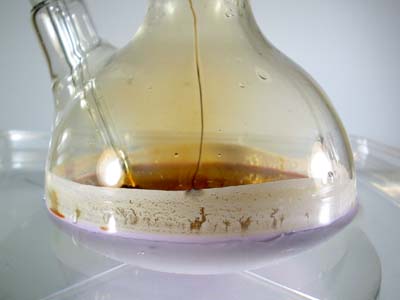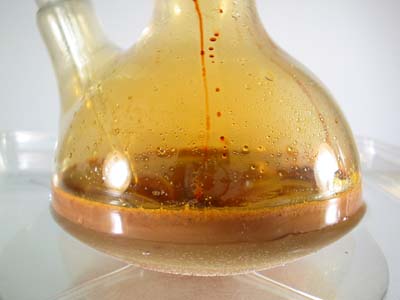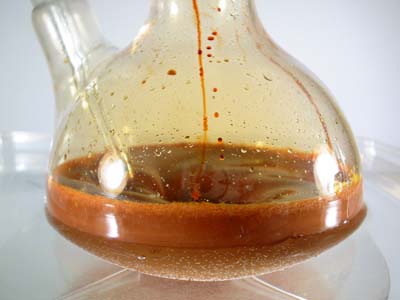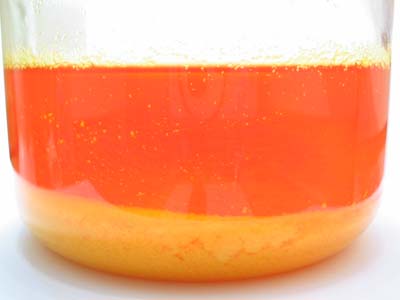The_Davster
A pnictogen
      
Posts: 2861
Registered: 18-11-2003
Member Is Offline
Mood: .
|
|
Picric Acid And Styphnic acid Problems
Recently I ran out of the picric acid that I had prepared around 6 months ago. So, of course I had to prepare more. My procedure was as
follows(based a bit on the powerlabs synthesis);
1. 10g ASA was disolved in 20mL 98% ACS sulfuric acid and was heated at 100C for 1h by means of a water bath.
2. The resulting product was cooled, along with 30mL 70%ACS nitric acid in the deepfreeze
3. When their temperatures had dropped below zero the nitric acid was added very slowly(drop-by-drop) keeping the NO2 evolution to a minimum while in
a water bath
4. The flask was removed from the waterbath and allowed to sit for a week with occasional swirling
5. It was then dumped into 120mL of ice water
This is where things started to go weird, I recieved no precipitate, and the solution was almost black. I managed to get a precipitate once I dumped
this into 500mL of ice water but even then the precipitate was black/brown. I filtered this and attempted to recrystalize from water. However even
when cooling to solidification after filtering the hot liquid during recrystallization I obtained no precipitate, but now the liquid was slightly
redder. I am currently evaporating some of this liquid.
Problem number 2
I tried the powerlabs styphnic acid synthesis. I followed the procedure exactly only half the scale
http://www.powerlabs.org/chemlabs/styphnic.htm
Yet again my problem occured upon attempting to precipitate. I recieved no yellow precipitate, only, yet again, a black solution which upon cooling
in the freezer still has precipitated nothing
Edit: Forgot to mention but when a bit of either the picric or styphnic acid solutions are added to water the solution still turns the expected yellow
and both also stain yellow. So there is the acid in there.
[Edited on 3-10-2004 by rogue chemist]
|
|
|
JohnWW
International Hazard
    
Posts: 2849
Registered: 27-7-2004
Location: New Zealand
Member Is Offline
Mood: No Mood
|
|
What did you blow up with the picric acid you made 6 months ago?
BTW It, styphic acid, and some other aromatic nitro-compounds, are also used as yellow dyes, as well as explosives.
John W.
|
|
|
Mephisto
Chemicus Diabolicus
  
Posts: 295
Registered: 24-8-2002
Location: Germany
Member Is Offline
Mood: swinging
|
|
The nitrating acid often destroys the desired product by reacting further with it after a too long time. Thats the reason, why nitrated products had
to be washed thoroughly to remove all traces of the nitrating acid. So, stirrung the mixture one week isn't advisible.
Did you let the styphnic acid mixture also stay for a week?
|
|
|
The_Davster
A pnictogen
      
Posts: 2861
Registered: 18-11-2003
Member Is Offline
Mood: .
|
|
JohnWW, I was not using the picric acid as an explosive by itself, I was experimenting with a few picrates after having the vial of picric acid
sitting on a shelf unused for months. The last .1g of my picric acid was used to make hexamine dipicrate.
Mephisto; The styphnic acid, after adding the nitric acid to the sulphonated resorcinol was left outsidde for around 20 min with occasional stirring.
When I came back outside to stirr once the reaction mix had frothed up with an orange foam on top and a black liquid on the bottom. This is when I
brought it back inside. Surprisingly I was unable to smell any NO2 during the entire styphnic acid procedure.
[Edited on 3-10-2004 by rogue chemist]
|
|
|
Mephisto
Chemicus Diabolicus
  
Posts: 295
Registered: 24-8-2002
Location: Germany
Member Is Offline
Mood: swinging
|
|
Styphnic acid
I don't know what could be the failure in your styphnic acid synthesis. Maybe too high temperatures and thermal decomposition, in this case
(black reaction-mixture...). The orange gases were certainly NOx. Please post more details, and I'm sure, someone will find the bug.
It was only two years ago, when I also tried out this method. Fortunately I found the pictures, which I've taken, on my HDD.

↑The sulphonated resorcinol (lilac color) with some droops of nitric acid.

↑More nitric acid and NOx.

↑Here you can see, that the mixture shouldn't be black.

↑Precipitation in water.
|
|
|
The_Davster
A pnictogen
      
Posts: 2861
Registered: 18-11-2003
Member Is Offline
Mood: .
|
|
Mephisto there was an orange foam after addition of all the nitric, not orange gasses. Even when the foam was broken up I was unable to detect any
smell of NO2. Where as with the picric acid after slowly adding the nitric acid it continued creating NO2 for a week, which is why I let the picric
reaction mix sit for a week, I assumed the reaction was not finished.
My nitric acid has turned very slightly yellow but the yellow color is inly visible when it is in the bottle. The nitric appears clear while in a
graduated cylinder.
|
|
|
Mephisto
Chemicus Diabolicus
  
Posts: 295
Registered: 24-8-2002
Location: Germany
Member Is Offline
Mood: swinging
|
|
Strange
The mixture didn't evolves NO2-fumes even when heated on the heat source?
Your nitric acid was ~68% and you did your synthesis mostly like the 'powerlabs'-procedure, right? (The slightly yellow color of your nitric
acid isn't a problem.)
|
|
|
The_Davster
A pnictogen
      
Posts: 2861
Registered: 18-11-2003
Member Is Offline
Mood: .
|
|
Nope, no fumes at all during the entire final heating for 1.5h, I was able to do this inside without any means to get rid of any NO2 fumes.
And, yes the powerlabs procedure almost to the letter only 1/2 the scale. He is unclear whether to add the nitric all at once or slowly.
|
|
|
Mephisto
Chemicus Diabolicus
  
Posts: 295
Registered: 24-8-2002
Location: Germany
Member Is Offline
Mood: swinging
|
|
The nitric acid had to be added in such a rate to avoid a higher temperature of the mixture than 30 °C.
*[According to US patent 2246963 (large scale process)]
|
|
|